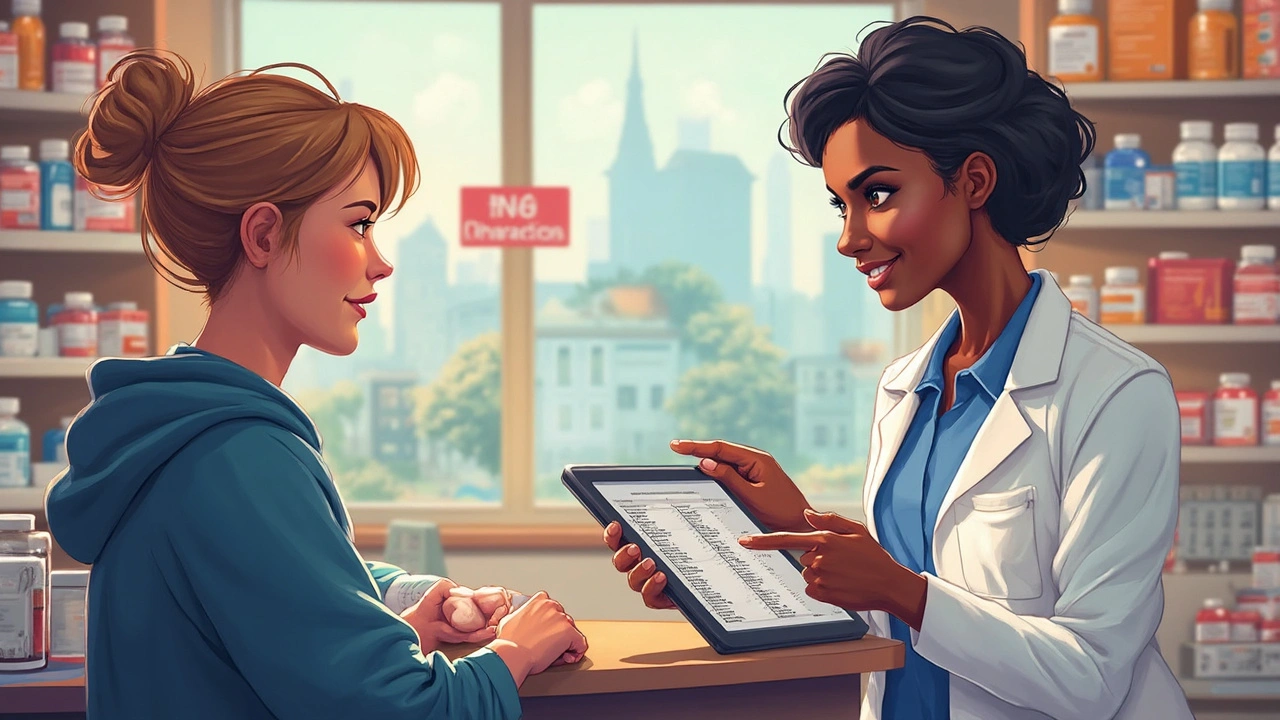Clindamycin phosphate is an antibiotic often prescribed for bacterial infections, but knowing how it interacts with other medications is key. Prescriptions can sometimes feel like a balancing act, especially when your medicine cabinet resembles a small pharmacy of its own.
So, what should you know about incorporating clindamycin phosphate into your routine? For starters, it's no secret that every drug has the potential to play nice—or not so nice—with others. Ever thought about how clindamycin interacts with blood thinners or certain muscle relaxants? These interactions are more common than you might guess and can impact how well your treatments work.
Managing drug interactions isn't just for pharmacists; a bit of knowledge goes a long way. Have a list of your medications at hand, and don't shy away from checking in with your healthcare provider if something feels off. And yes, your supplement stack counts too! Who knew that something as simple as drinking a glass of grapefruit juice could sometimes steer the effectiveness of your medication down unexpected paths?
- Understanding Clindamycin Phosphate
- Common Drug Interactions
- Risks of Ignoring Interactions
- Practical Tips for Safe Use
- When to Consult a Professional
- Stay Informed and Safe
Understanding Clindamycin Phosphate
Got an infection and your doctor mentioned something about clindamycin phosphate? No worries, let's break it down. Clindamycin phosphate is an antibiotic that's useful for fighting a range of bacterial infections. It's like the knight in shining armor for those pesky bacteria causing havoc.
This medication works by stopping the growth of bacteria. While it doesn't kill bacteria outright, it halts their ability to multiply, giving your immune system the upper hand. Doctors usually prescribe it for things like skin infections, respiratory infections, and sometimes even dental infections.
How It's Taken
You might see clindamycin phosphate in different forms: capsules, topical solutions, or injections. How you take it really depends on what you're up against. Make sure you follow the prescribed course, even if you start feeling better. Incomplete courses can let bacteria survive, possibly becoming resistant.
Quick Facts
- Duration: Most courses run from 7 to 14 days.
- Common Side Effects: Upset stomach, diarrhea, and possible allergic reactions.
- Important Note: It's not effective against viral infections like the cold or flu.
Like any medication, clindamycin phosphate has its sidekicks and nemeses in the form of interactions. But don't fret, as long as you know what to expect and communicate with your healthcare provider, you're set to use this antibiotic safely and effectively.
If you're ever in doubt or notice anything unusual while taking clindamycin phosphate, it's a no-brainer to reach out to your doctor. It's always better to be informed and proactive when it comes to your health.
Common Drug Interactions
When it comes to clindamycin phosphate, being aware of drug interactions is like having the secret recipe to good health. Some interactions can be more common and impactful than you might think.
Blood Thinners Alert
If you're on blood thinners like warfarin, pairing them with clindamycin phosphate could be tricky. This combo might increase bleeding risk, making it essential to monitor your health and communicate with your healthcare provider.
Muscle Relaxants Caution
Ever mixed muscle relaxants with clindamycin phosphate? These can amplify each other's effects, leading to prolonged muscle relaxation. It might sound ideal after a long workday, but too much relaxation can quickly cross over into unhealthy territory.
Stomach Medications
Avoid using stomach medications, particularly those that affect gut motility, as they might decrease the absorption of clindamycin phosphate. This could reduce its effectiveness, which is not what you want when you're battling an infection.
| Drug Type | Potential Interaction |
|---|---|
| Blood Thinners | Increased bleeding risk |
| Muscle Relaxants | Amplified effects leading to prolonged relaxation |
| Stomach Medications | Reduced absorption and effectiveness |
Monitoring and understanding these interactions is critical. A simple habit like keeping an updated list of your prescriptions and supplements can help your healthcare provider avoid these clashes. Remember, open communication with your doctor can make all the difference in maintaining both effectiveness and safety.
Risks of Ignoring Interactions
You might be thinking, "What's the worst that could happen if I ignore potential drug interactions with clindamycin phosphate?" Well, here's the thing—underestimating these interactions can sometimes lead to more harm than good.
Potential Side Effects
When clindamycin phosphate doesn't get along with other medications, it can trigger unwanted side effects. For instance, mixing it with certain blood thinners can increase bleeding risks. Yikes, right? Sometimes, it can cause digestive issues too, like nausea or diarrhea, which isn't fun for anyone.
Decreased Effectiveness
If ignored, interactions might weaken the antibiotic's effectiveness. Imagine, you pop these pills expecting results, and it turns out, that other medication you're also taking is canceling out its effects. It's like investing time and money into something that doesn't work—frustrating and costly.
Serious Health Complications
In rare cases, adverse interactions can result in severe complications. For example, patients with neuromuscular disorders could face heightened muscle weakness if clindamycin phosphate interacts with specific muscle relaxants. Not just discomfort; we're talking about potential health hazards that could send you back to the doctor's office.
How Frequent Are These Risks?
| Interaction Type | Common Percentage |
|---|---|
| Gastrointestinal Issues | 10-15% |
| Bleeding Risks (with blood thinners) | 5-7% |
| Neuromuscular Decrease | 2-3% |
Always better to be safe than sorry, right? Knowing this, wouldn’t it make sense to opine your pharmacist or healthcare provider about any new medication? They can give you a heads-up on anything you might have missed.

Practical Tips for Safe Use
When it comes to using clindamycin phosphate, being proactive can make all the difference. Here's a rundown of some practical tips to keep you safe and your treatment effective.
Review Your Medication List
Before starting clindamycin phosphate, gather a list of all your current medications. This includes prescriptions, over-the-counter drugs, and even supplements—everything counts! Presenting this to your healthcare provider is a good first step.
Communication is Key
Don’t play the guessing game when unsure. Have an open channel with your doctor or pharmacist. Ask about potential drug interactions every time you start a new medication. They can give you the lowdown on any red flags or changes needed.
Following Dosage Instructions
It might sound basic, but following dosage instructions precisely is crucial. Both taking too much or too little can skew effectiveness and increase side effects.
Stay Hydrated
Drinking plenty of water can help your body process antibiotics like clindamycin phosphate more efficiently. Aim for at least eight glasses a day, unless advised otherwise by your doc.
Avoid Self-Medication
No matter how tempting, don’t make changes to your medication routine without consulting healthcare professionals. Mixing and matching medications without expert guidance can lead to unwanted surprises.
Monitor for Side Effects
Keep an eye out for side effects. If anything unusual crops up, from mild rashes to gastrointestinal issues, alert your healthcare provider. They can help with adjusting your regimen or suggesting alternatives.
Using clindamycin phosphate responsibly involves a collaborative approach. You're part of a team aiming for the best health outcome. Stay informed, communicate, and always have your health partner in the loop.
When to Consult a Professional
There are moments when navigating the labyrinth of medications and their interactions can get a bit overwhelming. Knowing when to seek the advice of a healthcare provider is key, especially when dealing with clindamycin phosphate and other meds.
Experiencing Side Effects
If you’re on clindamycin phosphate and start feeling dizzy, nauseous, or notice any new symptoms, it's time to ring up your doctor. Don’t ignore signs that something’s amiss – better safe than sorry!
Introducing New Medications
Starting a new medication alongside your current regimen? Always a good idea to check in with a professional. Certain drugs like blood thinners or antihistamines can have unexpected interactions.
Changes in Health Status
Health can be unpredictable. If you experience changes such as pregnancy or develop new health conditions, it's a smart move to consult your healthcare provider to ensure your medications are still the right fit.
Understanding the Interactions
Perhaps you’re curious about how clindamycin phosphate works with something you take over-the-counter or even a herbal supplement. It’s wise to ask your pharmacist or doctor. They can provide insights that Google might not capture fully.
Tablets can only take you so far without guidance. Stay proactive about your health journey and let the professionals light the way!
Stay Informed and Safe
Staying up-to-date about clindamycin phosphate and its potential interactions is like having a secret weapon for better health. You've got to arm yourself with the right information, especially since something as minor as a herbal supplement can interfere with how your antibiotics work. The more you know, the better you can manage your treatment in sync with other medications.
Keep an Eye on New Medications
Changes in your prescription list are inevitable, but don't just accept new meds without question. Always check how a new drug might interact with your current ones, particularly clindamycin phosphate. Doctors and pharmacists are great resources, but sometimes a double-check is worth the peace of mind.
Don't Ignore Side Effects
If you notice anything unusual after starting clindamycin, take note. Symptoms like stomach issues or unusual bleeding can signal an interaction. Better nip it in the bud by consulting a healthcare professional rather than brushing these signs aside.
The Power of the Label
Think of medication labels as your go-to guide. They’re not just bits of paper wrapped around a bottle; they contain crucial info on side effects, dosage, and interactions. Let’s face it, warnings about something like grapefruit juice might seem trivial until you're the one running into trouble.
Make Technology Work for You
In this digital age, why not take advantage of it? Apps like MyTherapy can help manage your medication schedule, track side effects, and alert you to possible drug interactions. They’re like having a personal assistant right on your phone.
- Always review labels for information on interactions.
- Document any unusual symptoms or changes in condition.
- Regularly consult with healthcare providers about new or discontinued medications.
- Use technology to help stay organized and informed.
Knowledge with an Expert's Touch
Nothing beats professional advice. Regular check-ins with your doctor provide valuable insights and help you stay on top of your clindamycin phosphate regimen. It never hurts to ask, ‘Is there anything new I should know?' – often, there’s more information coming out about drugs and interactions.


Herbert Lui
Clindamycin’s like that one friend who shows up to the party and suddenly everyone’s acting weird-quiet, twitchy, or just… off. You didn’t plan for it, but now you’re stuck figuring out why the vibe’s changed. Grapefruit juice? Really? I mean, sure, I get it-it’s not just for breakfast anymore. But still. The body’s a whole damn orchestra, and antibiotics? They’re the tuba player who doesn’t know when to stop.
And don’t even get me started on muscle relaxants. It’s like letting a sleepwalker drive your car. You think you’re chilling, but your muscles are doing the Macarena in slow motion while your brain screams, ‘NOPE.’
It’s not just about the pills-it’s about the silence between them. The gaps where you don’t talk to your pharmacist. The assumptions you make because ‘it worked before.’
We treat medicine like a grocery list. But your body? It’s not a vending machine. It’s a cathedral. And some prayers? They don’t mix.
Anyway. I just wanted to say: thank you for writing this. It’s rare to see someone actually talk about the quiet dangers. Most posts just say ‘ask your doctor.’ Like that’s the end of the conversation. It’s not. It’s the beginning.